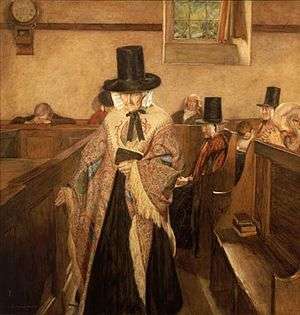Sydney Curnow Vosper
Sydney Curnow Vosper RWS, RWA (29 October 1866 – 10 July 1942) was an English painter and etcher of landscapes and figure subjects. His later work has a close association with Wales and Brittany. His most famous work is Salem (1908), which shows an old woman in the Welsh national costume, with Welsh hat and shawl, attending a service at Salem Baptist Chapel, Pentre Gwynfryn.
Sydney Curnow Vosper | |
|---|---|
 Salem (1908) | |
| Born | 29 October 1866 Stonehouse, Plymouth, Devon, England |
| Died | 10 July 1942 (aged 75) Shaldon, Devon |
| Nationality | English |
| Education | Académie Colarossi, Paris |
Personal history
Vosper was born in Stonehouse, Plymouth, in 1866 to Samuel, a brewer, and Eleanor Vosper. He attend a school in Somerset and Plymouth College. Following this he spent three years as an architect's apprentice before beginning his artistic career as an illustrator in London. He would later leave to study for three years at the Académie Colarossi in Paris, studying under Raphaël Collin. As a watercolour painter, Vosper began exhibiting his work in local art galleries throughout England, but also at the Paris Salon and the Royal Academy. Vosper painted landscapes but is perhaps best known for his figure painting. A favoured subject was the town and people of Le Faouët in Brittany.
A turning point in Vosper's work occurred when he married Constance James, the daughter of Frank T. James, a solicitor and former mayor of Merthyr Tydfil. This connection to Wales would change his output, and in his later career his paintings would be heavily influenced by Welsh culture and life. He died on 10 July 1942 at the Teign House Hotel, Shaldon, Devon, having also lived at Westbourne Terrace in the Bayswater district of London.[1]
Salem
Vosper's most famous work is Salem, a watercolour of the interior of Salem Chapel in Cefncymerau (modern day Llanbedr, Wales), with its central figure dressed in traditional Welsh costume, wrapped in a shawl and clutching a Bible. The painting, in watercolour on a piece of paper measuring 71.1 x 69.8 cm[2] was completed in 1908 and exhibited in the Royal Academy in London in 1909. Of the eight people in the painting, seven of them sat for Vosper, including the central character who was modelled by Siân Owen (1837–1927) of Ty’n-y-fawnog.[2] A dummy was used for the eighth, but only one was an actual member of Salem.[3] The painting was bought in 1909 in by industrialist William Hesketh Lever for 100 guineas. The painting gained mass appeal in Britain when it was used to promote Lever Brothers' Sunlight soap. The soap bars came with collectable tokens that could be exchanged for prints of the painting,[4] which resulted in many homes owning a copy, during a period when few homes owned any form of art.
In 1933 an article about the picture appeared in the Welsh language magazine Y Ford Gron (The Round Table) and in 1937 more copies of the print were sold for sixpence each through the Urdd. It was used in other press article and the Cymru Fydd calendar into the 1950s. In March 1942 it was described by Yr Aelwyd as ".. one of the most beautiful pictures of the religious life of Wales in old times .."[2]
The painting gained notoriety, when it was believed that the face of the devil could be seen in the folds of Siân Owen's shawl. Though this may be a reaction to the other often noticed illusion of a face staring through the chapel window, which in turn made people look for other supernatural elements or mistakenly thinking the face was in the shawl. The artist denied that he ever intentionally painted any such detail into the watercolour. The painting also became extremely popular in Wales, offering to a population, which was rapidly becoming industrialised, a reminder of a rural past[5] and a close connection to the Nonconformist religious background of the country. The painting is one of the most iconic images of Wales ever created.[6]
The work is presently exhibited at the Lady Lever Art Gallery at Port Sunlight in Cheshire, though there have been several request for the painting to be moved permanently to a Welsh museum.[7] In 2013 it formed the centrepiece of a temporary exhibition at the Gwynedd Museum and Art Gallery in Bangor.[8]
Siân Owen would feature in a second of Vosper's works, Market Day in Old Wales (c.1910).
Bibliography
- Waters, Grant M. (1975). Dictionary of British Artists Working 1900–1950. Eastbourne Fine Art. ISBN 978-0-904722-37-6.
- Williams, Tal (1991). Salem Y Llun a'r Llan/Painting and Chapel. Cyhoeddiadau'r Barddas. ISBN 978-1-906396-13-8.
References
- "No. 35968". The London Gazette. 1605. p. 6 April 1943.
- "Nostalgic image still fascinates, a hundred years on". Western Mail. walesonline.co.uk. 16 October 2010. Retrieved 16 October 2010.
- Davies, John; Jenkins, Nigel (2008). The Welsh Academy Encyclopaedia of Wales. Cardiff: University of Wales Press. p. 795. ISBN 978-0-7083-1953-6.
- Gower, Jon (23 May 2002). "Salem exhibition visits castle". BBC. Retrieved 16 October 2010.
- Gathering the Jewels Archived 5 June 2011 at the Wayback Machine
- Salem (1908) Archived 14 August 2011 at the Wayback Machine National Museums, Liverpool F.C.
- "Call to return Salem painting". BBC. 24 June 2005. Retrieved 16 October 2010.[ ] BBC News
- "Salem painting memories on show at Gwynedd Museum". BBC. 29 June 2013. Retrieved 29 June 2013.